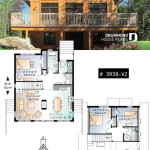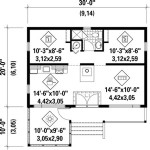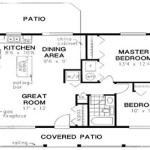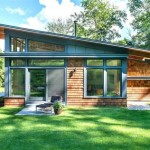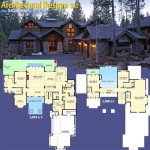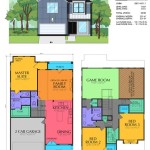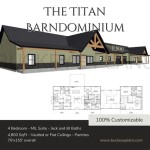Modern Farmhouse Plans: The Appeal of One-Story Living
The modern farmhouse style has captivated homeowners with its blending of rustic charm and contemporary convenience. This design aesthetic thrives on creating comfortable, inviting spaces that evoke a sense of warmth and simplicity. When combined with the practicality of a one-story layout, modern farmhouse plans offer an accessible and highly desirable living experience. This article explores the key features, benefits, and considerations associated with modern farmhouse plans designed for single-story homes.
The core philosophy behind modern farmhouse architecture is rooted in creating spaces that are both functional and aesthetically pleasing. Elements such as clean lines, natural materials, and an emphasis on light are hallmarks of the style. The one-story design enhances these attributes by promoting accessibility, ease of maintenance, and a stronger connection to the surrounding landscape. Furthermore, the single-level layout often fosters a more cohesive and interconnected living environment within the home.
The increasing popularity of one-story modern farmhouse plans reflects a shift in homeowner preferences, influenced by factors such as aging-in-place considerations, a desire for simplified living, and the appeal of a more relaxed and informal lifestyle. The following sections will delve into specific aspects of these plans, highlighting their unique advantages and design considerations.
Accessibility and Universal Design Principles
One of the most significant advantages of a one-story modern farmhouse plan is its inherent accessibility. The absence of stairs eliminates a major barrier for individuals with mobility challenges, making the home suitable for people of all ages and abilities. This is particularly relevant for individuals planning to age in place, allowing them to remain in their homes comfortably and safely for many years to come.
The principles of universal design are often incorporated into one-story modern farmhouse plans to further enhance accessibility. These principles focus on creating spaces that are usable by as many people as possible, regardless of their abilities. Examples of universal design elements include wider doorways and hallways, roll-in showers, lever handles on doors, and adjustable-height countertops. Integrating these features from the outset can significantly improve the long-term usability and value of the home.
Beyond simply eliminating stairs, one-story plans can be adapted to address a wide range of accessibility needs. Ramps can be seamlessly integrated into the entryway design, providing a smooth and gradual transition from the exterior to the interior. Open floor plans further enhance accessibility by creating unobstructed pathways and allowing for easier maneuverability within the home. Furthermore, careful consideration can be given to the placement of essential living spaces, such as the master bedroom and bathroom, to ensure they are conveniently located and easily accessible.
Modern farmhouse design elements complement accessibility considerations effectively. For example, the use of natural light, a common feature of farmhouse design, can improve visibility and reduce the need for artificial lighting, which can be beneficial for individuals with visual impairments. Similarly, the emphasis on natural materials, such as wood and stone, can create a tactile environment that is easier to navigate for individuals with sensory sensitivities.
The combination of a one-story layout and universal design principles transforms the modern farmhouse plan into a truly inclusive and adaptable living space, catering to the diverse needs of homeowners and their families.
Design Elements and Material Choices
The aesthetic appeal of a modern farmhouse extends beyond its structural layout, heavily relying on specific design elements and material choices. One-story plans provide a unique canvas for showcasing these features, allowing for a seamless integration of indoor and outdoor living spaces.
Exterior architectural details often include gabled roofs, covered porches, and board-and-batten siding. These elements contribute to the quintessential farmhouse look while adding depth and visual interest to the home's facade. The use of natural materials, such as wood, stone, and brick, further enhances the rustic charm of the design. Large windows and sliding glass doors are strategically placed to maximize natural light and provide unobstructed views of the surrounding landscape.
Interior design elements typically feature open floor plans, shiplap walls, exposed beams, and hardwood floors. These features create a sense of spaciousness and warmth, while also reflecting the simplicity and functionality of traditional farmhouse design. The use of neutral color palettes, such as whites, grays, and beiges, creates a calming and inviting atmosphere. Pops of color can be introduced through furniture, artwork, and accessories, adding personality and character to the space.
Material choices play a crucial role in defining the overall aesthetic of a modern farmhouse. Reclaimed wood, distressed finishes, and vintage hardware add a touch of rustic charm, while also contributing to the sustainability of the design. Natural stone countertops, farmhouse sinks, and pendant lighting fixtures further enhance the farmhouse aesthetic. The careful selection of materials can create a cohesive and visually appealing living space that reflects the homeowner's personal style.
In a one-story plan, the connection between indoor and outdoor spaces is particularly important. Covered porches and patios extend the living area, providing opportunities for outdoor dining, relaxation, and entertainment. Landscaping plays a crucial role in enhancing the curb appeal and creating a welcoming environment. Native plants, flowering shrubs, and mature trees can be strategically placed to complement the architectural design and create a sense of privacy.
The integration of specific design elements and material choices is essential for achieving the desired modern farmhouse aesthetic in a one-story plan. Careful consideration of these details can create a living space that is both beautiful and functional, reflecting the homeowner's unique style and preferences.
Energy Efficiency and Sustainable Practices
Modern farmhouse designs, especially in one-story layouts, can be optimized for energy efficiency and sustainability. This alignment with environmentally conscious practices contributes to lower utility bills and a reduced carbon footprint. Several design and construction strategies can be implemented to achieve these goals.
Proper insulation is paramount in minimizing heat loss during the winter and heat gain during the summer. High-performance insulation materials, such as spray foam and fiberglass batts, can be installed in walls, attics, and crawl spaces to create a well-insulated building envelope. Sealing air leaks around windows, doors, and other openings is also crucial for preventing drafts and reducing energy consumption.
Energy-efficient windows and doors can significantly reduce energy loss. Double-paned or triple-paned windows with low-E coatings can minimize heat transfer and block harmful UV rays. Insulated doors with weather stripping can prevent drafts and improve energy efficiency. The strategic placement of windows can also maximize natural light and reduce the need for artificial lighting during the day.
Renewable energy systems, such as solar panels, can be integrated into the design to generate electricity and reduce reliance on fossil fuels. Solar panels can be installed on the roof or ground-mounted to capture sunlight and convert it into electricity. Solar water heaters can also be used to heat water for domestic use.
Water conservation measures can also be implemented to reduce water consumption. Low-flow toilets, showerheads, and faucets can significantly reduce water usage without sacrificing performance. Rainwater harvesting systems can be used to collect rainwater for irrigation and other non-potable uses. Drought-tolerant landscaping can also minimize the need for irrigation.
Sustainable building materials, such as reclaimed wood, bamboo flooring, and recycled content products, can be used to reduce the environmental impact of construction. These materials are often durable, long-lasting, and aesthetically pleasing. Choosing locally sourced materials can also reduce transportation costs and support local economies.
By incorporating energy efficiency and sustainable practices into the design and construction of a one-story modern farmhouse, homeowners can create a living space that is both comfortable and environmentally responsible. This approach not only reduces operating costs but also contributes to a healthier planet.

Single Story House Plans With Farmhouse Flair Blog Builderhouseplans Com

Single Story Farmhouse Plans Blog Eplans Com

One Story Modern Farmhouse Floor Plans

4 Bedroom 1 Story Modern Farmhouse Style Plan With Outdoor Living Area And Bonus Room Westchester Craftsman House Plans

Top 5 Favorite Modern Farmhouses Archival Designs

One Story Modern Farmhouse Floor Plans

One Story Farmhouse Plans Dream Home Source

Cuthbert Modern Farmhouse Plan One Story Designs

Single Story House Plans With Farmhouse Flair Blog Builderhouseplans Com

Plan 81654 Spacious 1 Story Modern Farmhouse With 2970 Sq Ft 4

